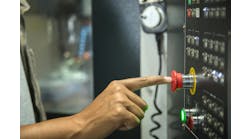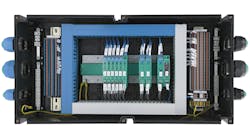Dan Hebert is senior technical editor for Control, Control Design and Industrial Networking.
A machine in which all rotating parts are at a complete standstill is undoubtedly safe, but also most likely unproductive. But many machines have certain components that rotate at slow speeds that are safe to a degree, not only practically, but also according to standards.
In terms of standards, most require a risk assessment to determine levels of risk and required protective measures. "The three commonly used factors for assessing risk are the severity of injury, frequency of occurrence and possibility of avoidance," says Ian Brough, safety product manager at Sick. "If a piece of machinery is moving very slowly or with low torque, all three of these factors are affected in some way. Severity and frequency could be affected slightly, but avoidance will be affected significantly in almost all cases."
Allowing operators to interact with these slowly rotating parts can allow increased production while still maintaining safe operations, greatly increasing productivity in many applications. The trick is to monitor the speed of the relevant rotating components in a simple yet safe manner, using control and sensing hardware that’s cost-effective, easy to use and safety-rated.
This is often referred to as safety-rated speed control, and it’s commonly achieved by monitoring rotary motion using multiple proximity sensors or encoders that connect to safety integrated modules (SIMs). SIMs produce a safety output that tells the user that the machine is completely stopped or below a certain predetermined speed deemed to be safe per the risk assessment.
A typical application for safety-rated speed control would be a machine that incorporates winding and/or unwinding operations. This could apply to anything that is wound on a roll, such as paper, metals or plastics.
For example, a paper roll machine might require paper to be fed into a newspaper printer or a slitter line. These rolls would need to be exchanged often and quickly, so the machine could be kept running. The exchange of the empty roll for a full roll could be very efficient if rotation were maintained, even at a slow speed. If the speed is safely-limited, an operator can be in very close proximity, while the end of the new roll is tacked to the end of the emptying roll. The machine can keep running without having to be fully stopped while the rolls are exchanged.
Speed sensing and other related technologies to accomplish the above have been around for quite some time, but now they can be integrated directly into drives and controllers on newer machines, instead of being supplied as an add-on.
For existing machines, new products are available that allow safety-rated speed control to be retrofitted, providing the same benefit. "Our safety controller with an added safety drive monitor allows a user to apply safe speed monitoring and control to drive systems that are currently in the field," Brough points out. "These controllers can be applied to all types of drives, and they include safe motion functions such as safe speed monitor, safe limited speed, safe direction indication, safe speed one and safe operating stop. These are just a few ISO-approved functions. There are about 22 in total."
Another application for safety-rated speed control is the safeguarding of automated guided vehicles (AGVs) or carts. "Today, safety laser scanners are used as active ‘optical bumpers’ to ensure collisions don’t happen," Brough explains. "Maximum speeds can’t be attained unless large protective fields are used, and this can limit where AGVs can be most productive. If a user can safely switch these field areas based on safety-rated speed control, users gain productivity in a safe manner."
Essentially, the protective field area is increased as the speed of the AGV decreases and vice versa, allowing the AGV to operate at the maximum safe speed in each plant area.
With safety-rated speed control, the protective field area increases as the speed of the AGV decreases, and decreases as the speed of the AGV increases, allowing the AGV to operate at the maximum safe speed in each plant area.
Personnel often are tempted to work in areas that they deem safe due to low speeds of rotating or mobile equipment, but safety-rated speed control based on sound engineering principles takes that decision about allowing or prohibiting work out of their hands.





